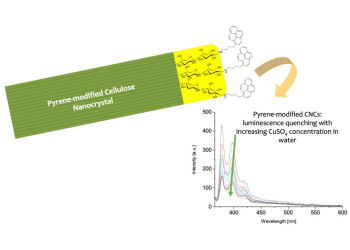 The reductive amination reaction is an interesting tool to achieve one terminus functionalization of cellulose nanocrystals. Since at NanoLeaves laboratory we are interested in novel applications of CNCs, we have used pyrene luminescence to understand if the new functionality introduced on CNCs may interact preferentially with some metal cations. In our work we compare the behavior of reductively aminated CNCs deriving from sulfuric acid hydrolysis or hydrochloric acid hydrolysis (that we named neutral CNC, N_CNC). Pyrene luminescence in water is used as a probe to understand if some selective or preferential interaction with metal cation achieves involving the pyrene portion of the nanocrystals.
The reductive amination reaction is an interesting tool to achieve one terminus functionalization of cellulose nanocrystals. Since at NanoLeaves laboratory we are interested in novel applications of CNCs, we have used pyrene luminescence to understand if the new functionality introduced on CNCs may interact preferentially with some metal cations. In our work we compare the behavior of reductively aminated CNCs deriving from sulfuric acid hydrolysis or hydrochloric acid hydrolysis (that we named neutral CNC, N_CNC). Pyrene luminescence in water is used as a probe to understand if some selective or preferential interaction with metal cation achieves involving the pyrene portion of the nanocrystals.
With this paper, we demonstrate how we manipulate N_CNC in suspension and how we can achieve selective interaction with cations in water, discarding other chemically or optically interfering phenomena.
This is a fundamental study on the usefulness of the reductive amination reaction performed on nanocellulose. This topic is presently object of research at the NanoLeaves Lab, as usual with the aim of achieving unconventional applications of nanocellulose.
